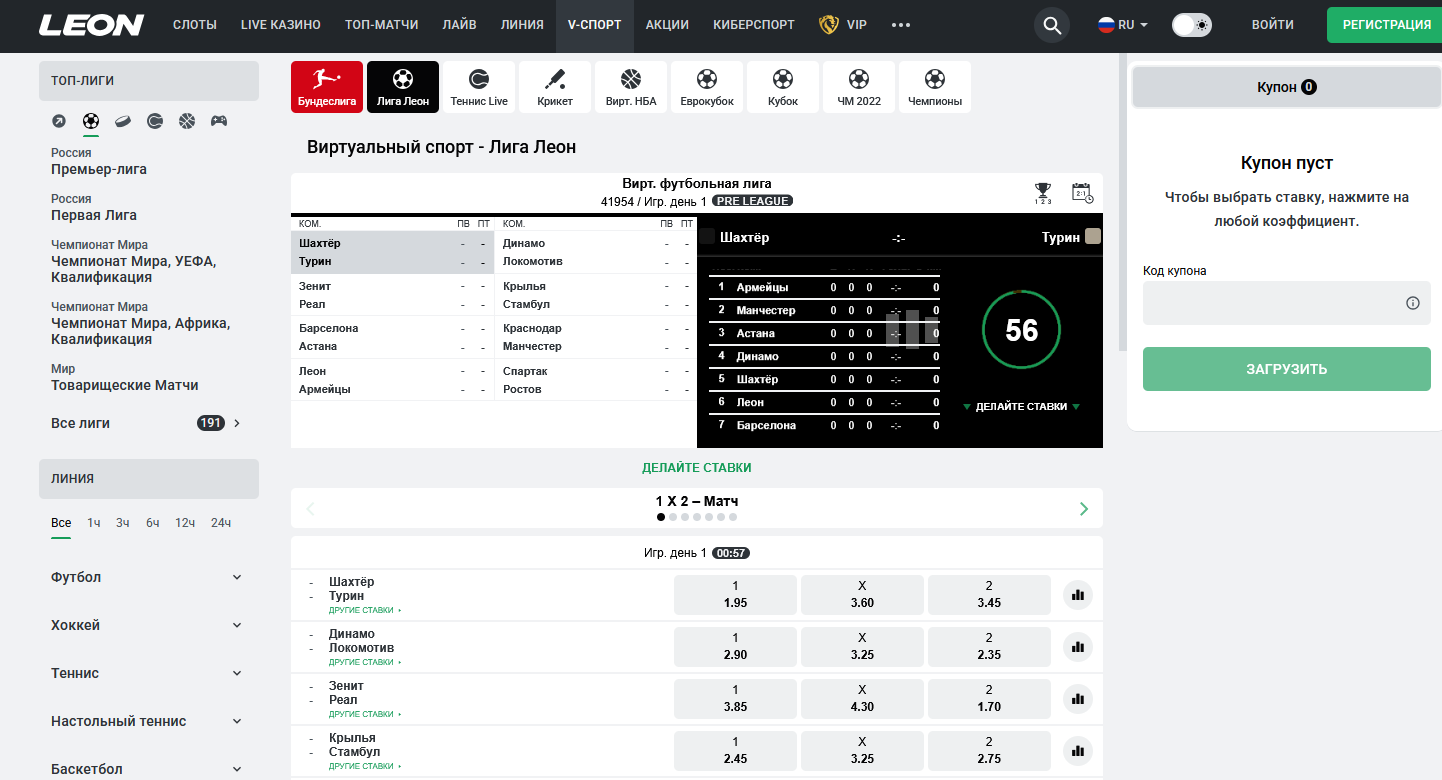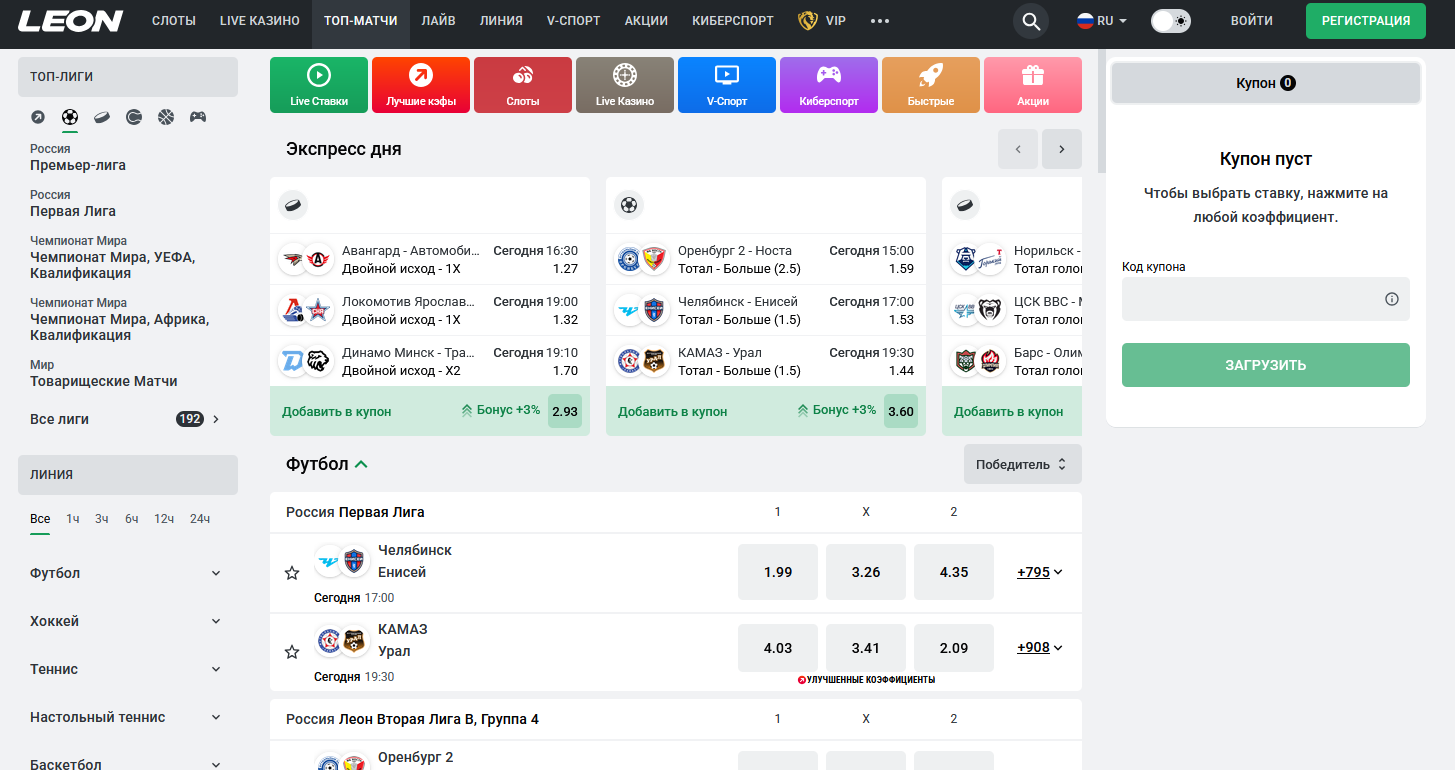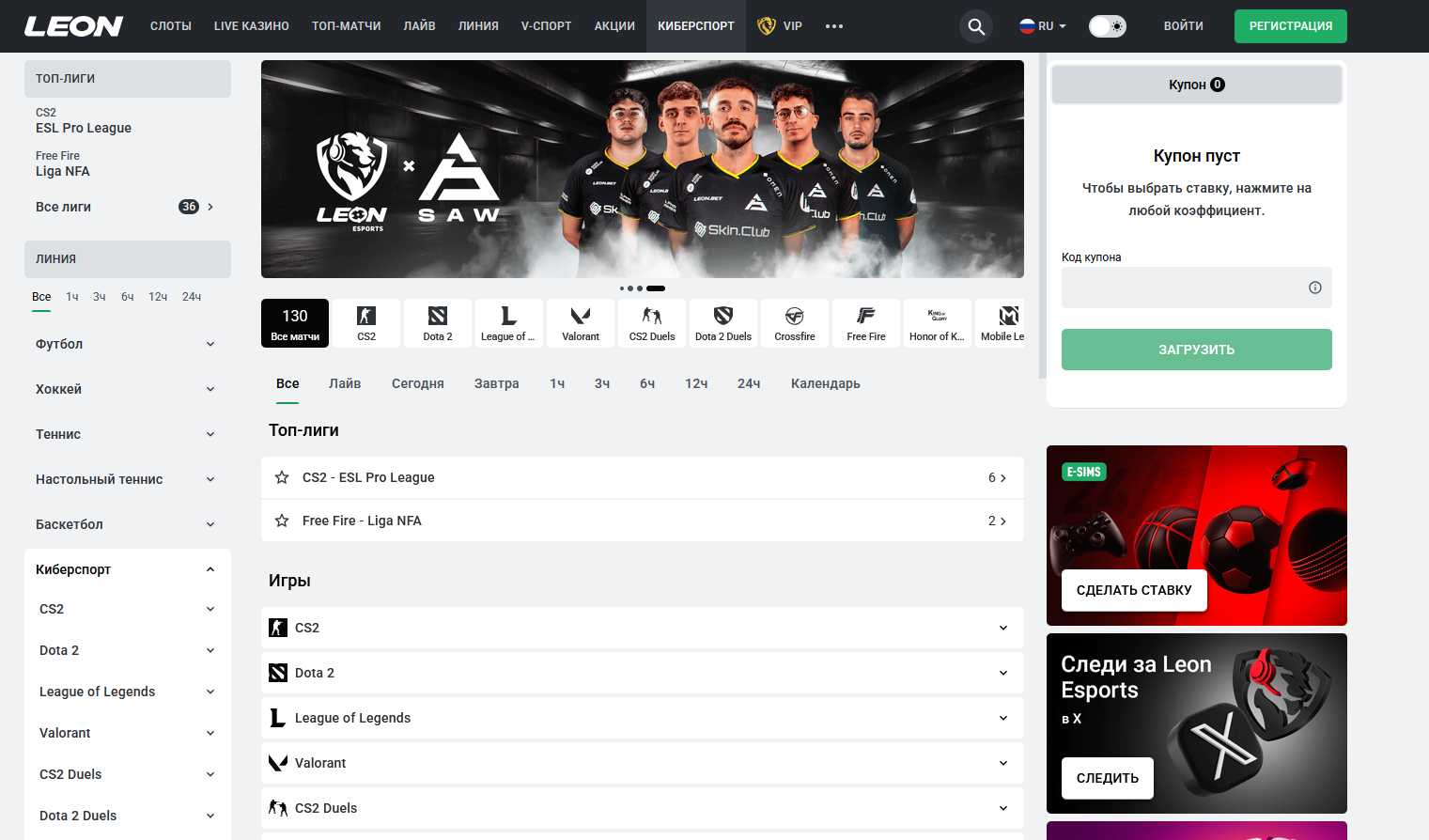
Leon Casino — это премиальная игровая платформа, которая объединяет более 4000 развлечений от ведущих мировых провайдеров. Казино Леон предлагает игрокам из СНГ и Европы безопасную среду для азартных игр с быстрыми выплатами и щедрой бонусной программой. С 2012 года платформа зарекомендовала себя как надежный оператор с лицензиями Antillephone и Kahnawake и безупречной репутацией среди миллионов пользователей.
Основная информация о казино Леон
Leon Casino работает под управлением международной компании с юридическим адресом в Виллемстаде, Кюрасао. Платформа входит в экосистему букмекерской конторы Leonbets, что гарантирует финансовую стабильность и профессиональный подход к организации игрового процесса.
Карточка казино Leon
| Параметр | Значение |
|---|---|
| Официальный сайт | leon.bet, leon.casino |
| Год основания | 2012 |
| Лицензия | Antillephone N.V. №8048/JAZ/2016-028 + Kahnawake №00881 |
| Юридический адрес | Виллемстад, Кюрасао |
| Количество игр | 4000+ слотов и настольных игр |
| Провайдеры | 100+ ведущих разработчиков |
| Режимы игры | Демо-версия / Реальные деньги |
| Доступные страны | Казахстан, Узбекистан, Беларусь, Украина, страны Европы |
| Валюты | USD, EUR, KZT, UAH, BYN, UZS, BTC, ETH, USDT |
| Языки интерфейса | Русский, Английский, Немецкий, Турецкий |
| Мобильная версия | Адаптивный сайт + iOS/Android приложения |
| Сроки вывода | От 15 минут до 24 часов |
| Лимиты вывода | 1000 - 500000 USD в сутки |
| Поддержка | 24/7 Live Chat, Email, Telegram |
Почему выбирают Leon Casino
Казино Леон выделяется среди конкурентов благодаря уникальному сочетанию факторов. Во-первых, это большая библиотека игр с эксклюзивными слотами от Pragmatic Play и NetEnt. Во-вторых, молниеносная обработка платежей — выводы на электронные кошельки приходят за 15-30 минут. В-третьих, круглосуточная русскоязычная поддержка, которая решает любые вопросы в течение 2-3 минут через live-чат.
Игровой каталог Leon Casino
Коллекция развлечений в казино Леон впечатляет разнообразием. Здесь собраны лучшие разработки от 100+ провайдеров, включая эксклюзивные релизы и джекпот-слоты с призовыми фондами до 10 миллионов долларов.
Общая статистика игровой библиотеки
Leon Casino предлагает более 4000 игр, которые регулярно пополняются новинками. Каждую неделю каталог обновляется 10-15 свежими релизами. Все игры проходят сертификацию и имеют подтвержденный RTP от 94% до 99%.
Категории игр и провайдеры
| Категория | Количество | Особенности | Топ-провайдеры |
|---|---|---|---|
| Слоты | 2500+ | Классические 3-барабанные, видеослоты, 3D-графика, Megaways, прогрессивные джекпоты | Pragmatic Play, NetEnt, Microgaming, Play'n GO, Yggdrasil |
| Live Casino | 400+ | Рулетка, баккара, блэкджек, покер, игровые шоу, монополия | Evolution Gaming, Pragmatic Live, Ezugi, Vivo Gaming |
| Настольные игры | 200+ | Европейская и американская рулетка, 15 видов блэкджека, покер, баккара | NetEnt, Playtech, Betsoft, Habanero |
| Быстрые игры | 150+ | Авиатор, JetX, Spaceman, Lucky Jet, краш-игры, кено, бинго | Spribe, Smartsoft, BGaming, Evoplay |
| Виртуальный спорт | 100+ | Футбол, теннис, баскетбол, скачки, собачьи бега | Kiron, GoldenRace, Leap Gaming |
| Турбо-игры | 100+ | Мини-рулетка, быстрый покер, спин-колесо | Betgames, TVBet, 1xGames |
Уникальные возможности игрового процесса
Leon Casino предлагает инновационные функции для максимального комфорта игроков:
- Мультиплей режим — запускайте до 4 слотов одновременно на одном экране
- Турбо-спины — ускоренная прокрутка барабанов для быстрой игры
- Автоигра с лимитами — настройка автоматических ставок с контролем бюджета
- История ставок — детальная статистика всех игровых сессий за 6 месяцев
- Избранные игры — персональная коллекция любимых слотов
- Демо-режим — бесплатное тестирование всех игр без регистрации
- Поиск по волатильности — фильтрация игр по уровню риска
Топ-5 популярных слотов в Leon Casino
1. Sweet Bonanza (Pragmatic Play)
- RTP: 96.48%
- Волатильность: Высокая
- Максимальный выигрыш: x21,100 от ставки
- Минимальная/Максимальная ставка: 20 / 10,000 единиц
- Линии выплат: Кластерные выигрыши
- Особенности: Каскадные барабаны, множители до x100, бонус-раунд с 10 фриспинами
2. Book of Dead (Play'n GO)
- RTP: 94.25%
- Волатильность: Высокая
- Максимальный выигрыш: x5,000 от ставки
- Минимальная/Максимальная ставка: 10 / 5,000 единиц
- Линии выплат: 10 фиксированных
- Особенности: Расширяющиеся символы, риск-игра, 10 бесплатных вращений
3. Crazy Time (Evolution Gaming)
- RTP: 95.00%
- Волатильность: Средняя
- Максимальный выигрыш: x20,000 от ставки
- Минимальная/Максимальная ставка: 10 / 50,000 единиц
- Тип игры: Live game show
- Особенности: 4 бонусных раунда, колесо фортуны, множители до x50
4. Gates of Olympus (Pragmatic Play)
- RTP: 96.50%
- Волатильность: Высокая
- Максимальный выигрыш: x5,000 от ставки
- Минимальная/Максимальная ставка: 20 / 10,000 единиц
- Линии выплат: Pay Anywhere (оплата везде)
- Особенности: Множители от Зевса до x500, покупка бонуса за 100x
5. Aviator (Spribe)
- RTP: 97.00%
- Волатильность: Регулируемая игроком
- Максимальный выигрыш: x200 от ставки
- Минимальная/Максимальная ставка: 10 / 10,000 единиц
- Тип игры: Краш-игра
- Особенности: Две одновременные ставки, автокэшаут, живая статистика

Бонусная программа казино Леон
Leon Casino предлагает одну из самых щедрых бонусных программ на рынке. Новые игроки получают приветственный пакет до 500,000 единиц, а постоянные пользователи участвуют в еженедельных акциях и турнирах с призовыми фондами до 1,000,000 единиц.
Приветственный пакет для новых игроков
Казино Леон встречает новичков роскошным бонусным предложением на первые 5 депозитов:
| Депозит | Бонус | Фриспины | Вейджер | Минимальный депозит |
|---|---|---|---|---|
| 1-й депозит | 100% до 50,000 | 200 FS в Book of Dead | x35 | 1,000 единиц |
| 2-й депозит | 50% до 75,000 | 100 FS в Sweet Bonanza | x30 | 2,000 единиц |
| 3-й депозит | 50% до 100,000 | 50 FS в Gates of Olympus | x30 | 3,000 единиц |
| 4-й депозит | 25% до 125,000 | — | x25 | 5,000 единиц |
| 5-й депозит | 25% до 150,000 | — | x25 | 5,000 единиц |
Условия отыгрыша:
- Срок отыгрыша: 30 дней с момента активации
- Максимальная ставка при отыгрыше: 500 единиц
- Игры с полным вкладом: слоты (100%), рулетка (10%), блэкджек (5%)
- Вывод после полного отыгрыша вейджера
Регулярные акции и турниры
| Тип акции | Частота | Условия участия | Награда |
|---|---|---|---|
| Кэшбэк | Еженедельно | Проигрыш от 5,000 единиц | 10-15% возврата до 50,000 |
| Релоад-бонус | Пятница | Депозит от 2,000 единиц | 50% до 30,000 + 50 FS |
| Drops & Wins | Ежедневно | Ставки в слотах Pragmatic | Призовой фонд 1,000,000 |
| Колесо Фортуны | Ежедневно | Депозит от 1,000 единиц | До 100 фриспинов |
| VIP-кэшбэк | Понедельник | VIP-статус Gold+ | 20% без вейджера |
| Турнир недели | Еженедельно | Buy-in 100 единиц | Призовой фонд 500,000 |
VIP-программа и привилегии
Leon Casino предлагает 7-уровневую программу лояльности с эксклюзивными преимуществами:
- Bronze (0-999 очков) — Приветственный бонус, базовый кэшбэк 5%
- Silver (1,000-4,999) — Кэшбэк 7%, ускоренный вывод
- Gold (5,000-14,999) — Кэшбэк 10%, персональный менеджер
- Platinum (15,000-49,999) — Кэшбэк 12%, эксклюзивные бонусы
- Diamond (50,000-149,999) — Кэшбэк 15%, VIP-турниры
- Master (150,000-499,999) — Кэшбэк 18%, подарки на день рождения
- Grandmaster (500,000+) — Кэшбэк 20%, поездки на EPT

Регистрация и верификация в казино Леон
Процесс создания аккаунта в Leon Casino занимает не более 2 минут. Платформа предлагает 4 удобных способа регистрации с минимальными требованиями к данным.
Способы регистрации
1. Регистрация по email (классическая)
- Шаг 1: Нажмите "Регистрация" и выберите вкладку Email
- Шаг 2: Укажите электронную почту и придумайте пароль (8+ символов)
- Шаг 3: Выберите валюту счета и страну проживания
- Шаг 4: Введите промокод (если есть) и согласитесь с правилами
- Шаг 5: Подтвердите email переходом по ссылке в письме
2. Регистрация по номеру телефона (быстрая)
- Введите номер мобильного телефона с кодом страны
- Получите SMS с кодом подтверждения (приходит за 10 секунд)
- Введите 4-значный код из SMS
- Выберите валюту и бонус
- Аккаунт готов к использованию
3. Регистрация в один клик (мгновенная)
- Нажмите "Регистрация в 1 клик"
- Система автоматически создаст логин и пароль
- Сохраните данные для входа (отправляются на email)
- Заполните профиль позже для вывода средств
4. Через социальные сети (удобная)
Доступна авторизация через:
- VKontakte
- Telegram
- Yandex
- Mail.ru
Верификация аккаунта
Верификация в Leon Casino требуется для вывода средств свыше 15,000 единиц или по запросу службы безопасности.
Необходимые документы:
- Паспорт или водительские права (фото первой страницы)
- Селфи с документом в руках
- Подтверждение адреса (коммунальный счет за последние 3 месяца)
- Фото банковской карты (если использовалась для депозита)
Сроки проверки:
- Стандартная верификация: 2-6 часов
- Расширенная проверка: до 24 часов
- VIP-игроки: приоритетная проверка за 30 минут
Лимиты без верификации:
- Максимальный вывод: 15,000 единиц в сутки
- Общая сумма выводов: 50,000 единиц в месяц
Платежные системы Leon Casino
Казино Леон поддерживает популярные платежные методы для игроков из СНГ. Пополнение счета происходит мгновенно, а вывод средств занимает от 15 минут до 24 часов в зависимости от выбранного метода.
Доступные методы пополнения и вывода
| Метод | Пополнение | Вывод | Мин/Макс | Комиссия | Время обработки |
|---|---|---|---|---|---|
| Банковские карты | ✓ | ✓ | 500 / 500,000 | 0% | Мгновенно / 1-3 дня |
| QIWI | ✓ | ✓ | 100 / 150,000 | 0% | Мгновенно / 15-60 мин |
| YooMoney | ✓ | ✓ | 100 / 200,000 | 0% | Мгновенно / 15-60 мин |
| WebMoney | ✓ | ✓ | 100 / 300,000 | 0% | Мгновенно / 1-6 часов |
| Payeer | ✓ | ✓ | 100 / 100,000 | 0% | Мгновенно / 15 мин |
| Perfect Money | ✓ | ✓ | 10 / 10,000 USD | 0% | Мгновенно / 1 час |
| Bitcoin | ✓ | ✓ | 0.0001 / 10 BTC | Сеть | Мгновенно / 10-60 мин |
| Ethereum | ✓ | ✓ | 0.01 / 100 ETH | Сеть | Мгновенно / 10-30 мин |
| USDT TRC-20 | ✓ | ✓ | 10 / 100,000 USDT | 1 USDT | Мгновенно / 5-20 мин |
| Банковский перевод | ✓ | ✓ | 5,000 / 10,000,000 | 0% | 1-3 дня / 1-5 дней |
Особенности финансовых операций
Конвертация валют: При несовпадении валюты платежного метода и игрового счета конвертация происходит автоматически по внутреннему курсу казино.
Приоритетные методы: Криптовалюты обрабатываются в первую очередь. VIP-игроки получают приоритет в очереди на вывод независимо от метода.
Ограничения по странам: Некоторые платежные методы доступны только для определенных регионов.
Безопасность и лицензия
Leon Casino уделяет первостепенное внимание безопасности игроков и честности игрового процесса. Деятельность казино регулируется двумя лицензиями, что гарантирует соблюдение международных стандартов.
Технологии защиты данных
- 256-bit SSL-шифрование — военный уровень защиты всех передаваемых данных
- 2FA аутентификация — дополнительная защита аккаунта через SMS или Google Authenticator
- Антифрод система — автоматическое выявление подозрительных транзакций
- PCI DSS Level 1 — высший уровень безопасности платежных данных
- Firewall и DDoS-защита — защита от хакерских атак и взломов
- Холодное хранилище — 95% средств хранятся офлайн
Честная игра и RNG
- RNG от iTech Labs — генератор случайных чисел с сертификатом соответствия
- Публикация RTP — открытая информация о проценте возврата каждой игры
- Проверка честности — возможность проверить каждый спин через хеш-функцию
- Ответственная игра — инструменты самоограничения и самоисключения
Лицензионная информация
Основная лицензия:
Antillephone N.V.
Номер:
8048/JAZ/2016-028
Юрисдикция:
Кюрасао
Дополнительная лицензия:
Kahnawake Gaming Commission
Номер:
00881
Юрисдикция:
Канада

Мобильная версия Leon Casino
Казино Леон предлагает полноценный мобильный гейминг через адаптивную версию сайта и native-приложения для iOS и Android.
Способы игры с мобильного
-
Мобильная версия сайта
- Автоматическая адаптация под любой экран
- Не требует установки
- Доступ через любой мобильный браузер
- 100% функционала десктопной версии
-
iOS приложение
- Доступно в App Store для iOS 12.0+
- Размер: 145 МБ
- Поддержка Face ID/Touch ID
- Push-уведомления о бонусах
-
Android приложение
- Скачивание APK с официального сайта
- Android 5.0+
- Размер: 89 МБ
- Автоматические обновления
-
PWA версия
- Прогрессивное веб-приложение
- Установка прямо из браузера
- Работа в офлайн-режиме
- Экономия трафика до 50%
Функциональность мобильной версии
Отличия от десктопа:
- Упрощенная навигация свайпами
- Вертикальная ориентация слотов
- Адаптированные live-игры
Эксклюзивные функции:
- Быстрая авторизация по отпечатку пальца
- Портретный режим для одной руки
- Виджеты избранных игр на главном экране
Системные требования:
- iOS: iPhone 6s и новее, iOS 12.0+
- Android: 2 ГБ RAM, Android 5.0+
- Интернет: стабильное 3G/4G/Wi-Fi соединение
Поддержка игроков
Служба поддержки Leon Casino работает круглосуточно и готова помочь на русском языке через несколько каналов связи.
Каналы связи с поддержкой
| Канал | Доступность | Языки | Время ответа |
|---|---|---|---|
| Live Chat | 24/7 | Русский, Английский | 30 секунд |
| 24/7 | 10 языков | До 2 часов | |
| Telegram | 09:00-02:00 MSK | Русский | 2-5 минут |
| 10:00-00:00 MSK | Русский, Английский | 5-10 минут | |
| Горячая линия | 10:00-22:00 MSK | Русский | Мгновенно |
Дополнительная помощь
- FAQ раздел — 200+ ответов на популярные вопросы
- Видео-туториалы — обучающие ролики по всем функциям казино
- Блог казино — новости, стратегии, обзоры игр
- Форум игроков — сообщество для обмена опытом
- База знаний — подробные инструкции и гайды

Преимущества и особенности казино Леон
Ключевые преимущества Leon Casino
✓
Мгновенные выплаты
— вывод на электронные кошельки за 15 минут
✓
4000+ лицензионных игр
— большая коллекция слотов в СНГ
✓
Бонус до 500,000
— щедрый приветственный пакет на 5 депозитов
✓
Live-казино 24/7
— 400+ столов с живыми дилерами
✓
Криптовалютные платежи
— анонимные транзакции в BTC, ETH, USDT
✓
VIP-программа
— 7 уровней лояльности с растущим кэшбэком до 20%
✓
Мобильные приложения
— native apps для iOS и Android
✓
Турниры каждый день
— призовые фонды до 1,000,000
✓
Профессиональная поддержка
— решение вопросов за 2-3 минуты
✓
Две лицензии
— Antillephone и Kahnawake с 2012 года

FAQ — Частые вопросы о казино Леон
Как начать играть в Leon Casino?
Зарегистрируйтесь одним из четырех способов (email, телефон, в 1 клик или через соцсети), подтвердите аккаунт, внесите первый депозит от 1000 единиц и получите приветственный бонус 100% + 200 фриспинов. После этого выберите любую игру из каталога и начинайте играть.
Как получить и отыграть бонус?
Бонусы начисляются автоматически при пополнении счета на сумму от минимального депозита. Для отыгрыша нужно сделать ставок на сумму бонуса, умноженную на вейджер (обычно x30-x35). Например, при бонусе 10,000 с вейджером x30 нужно поставить 300,000 в слотах.
Сколько времени занимает вывод средств?
Скорость вывода зависит от платежного метода: электронные кошельки — 15-60 минут, криптовалюта — 10-30 минут, банковские карты — 1-3 дня, банковский перевод — 1-5 дней. VIP-игроки получают приоритетную обработку заявок.
Можно ли играть с мобильного телефона?
Да, Leon Casino полностью адаптировано для мобильных устройств. Доступна мобильная версия сайта, которая работает в любом браузере, а также native-приложения для iOS (App Store) и Android (APK с сайта). Функционал мобильной версии идентичен десктопной.
Как связаться со службой поддержки?
Самый быстрый способ — live-чат на сайте (ответ за 30 секунд). Также доступны: email [email protected], Telegram @leon_support, WhatsApp и горячая линия для русскоязычных пользователей.
Какие документы нужны для верификации?
Для стандартной верификации потребуется: фото паспорта (первая страница), селфи с документом, подтверждение адреса (счет за коммунальные услуги не старше 3 месяцев), фото банковской карты (если использовалась). Документы загружаются в личном кабинете.
Есть ли в казино демо-режим?
Да, все слоты и настольные игры (кроме live-казино) доступны в бесплатном демо-режиме без регистрации. Это позволяет протестировать игры, изучить правила и выработать стратегию перед игрой на реальные деньги.
Какие есть ограничения для игроков?
Онлайн-казино запрещены в России на законодательном уровне. Leon Casino принимает игроков из Казахстана, Узбекистана, Беларуси, Украины и других стран, где азартные игры разрешены. Перед регистрацией ознакомьтесь с законодательством вашей страны.
